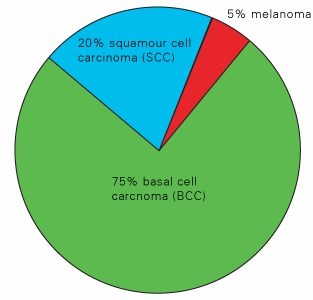Basal Cell Carcinoma and Vitamin D
Basal Cell Carcinoma reduced when Vitamin D levels kept above 25 ng – June 2019
Assessing the Effect of Vitamin D Replacement on Basal Cell Carcinoma Occurrence and Recurrence Rates in Patients with Vitamin D Deficiency
Horm Cancer. 2019 Jun 28. doi: 10.1007/s12672-019-00365-2
Ince B1, Yildirim MEC2, Dadaci M1.
1 Dept of Plastic & Reconstructive and Aesthetic Surgery, Meram Faculty of Medicine, Necmettin Erbakan University, 42080, Meram, Konya, Turkey.
2 Dept of Plastic & Reconstructive and Aesthetic Surgery, Meram Faculty of Medicine, Necmettin Erbakan University, 42080, Meram, Konya, Turkey. dr.cem_yildirim@hotmail.com.
The study aimed to determine whether 25-OH vitamin D3 deficiency is present in patients with diagnosed BCC, and the effect of vitamin D replacement on the rates of BCC recurrence in patients with 25-OH vitamin D3 deficiency. In this prospective study, between 2012 and 2017, in the first stage, 25-OH vitamin D3 levels of all patients diagnosed with BCC between 2012 and 2013 were evaluated. In the second stage between 2014 and 2015, we evaluated the 25-OH vitamin D3 level of patients who had 25-OH vitamin D3 level < 25 ng/mL. All the patients included in the second stage had BCC recurrence. In the third stage, the patients who were diagnosed 25-OH vitamin D3 deficiency with BCC, between 2015 and 2017, were studied. The mean 25-OH vitamin D3 level of the patients in the second stage was 10.12 ng/mL. Recurrence was observed in 9.64% of the patients in the second stage. The mean level of serum 25-OH vitamin D3 in the third stage was 40.1 ng/mL, and 3.49% of these patients presented with recurrence. In all the patients as the initial diagnosis and following the 25-OH vitamin D3 level in all the patients with BCC recurrence, maintaining 25-OH vitamin D3 levels above 25 ng/mL can significantly reduce the recurrence rate.
Topical and Intralesional Immunotherapy for the Management of Basal Cell Carcinoma - June 2024
Cancers 2024, 16(11), 2135; https://doi.org/10.3390/cancers16112135
Aurora Fernández-Galván 1,†,Pedro Rodríguez-Jiménez 1,2,*,†ORCID,Beatriz González-Sixto 3,María Teresa Abalde-Pintos 3 andBeatriz Butrón-Bris 1
Simple Summary
Basal Cell Carcinoma is the most prevalent cancer in the white population, with a 30% lifetime risk for individuals with fair skin. The main treatment goal is to completely remove the tumor while preserving function and appearance. Surgery is usually the preferred method due to its high success rates and the ability to verify that the entire tumor has been excised. However, topical and intralesional immunotherapy, although traditionally secondary to surgery, have demonstrated effectiveness and good cosmetic outcomes. These non-surgical treatments are valuable alternatives for patients who cannot undergo surgery. The objectives of this review are to summarize the current state of topical and intralesional immunotherapy treatments for BCC and to evaluate their potential as effective alternatives for certain patient populations.
Abstract
Basal Cell Carcinoma (BCC) is the most common type of cancer among the white population. Individuals with fair skin have an average lifetime risk of around 30% for developing BCC, and there is a noticeable upward trend in its incidence rate. The principal treatment objectives for BCC involve achieving the total excision of the tumor while maximizing the preservation of function and cosmesis. Surgery is considered the treatment of choice for BCC for two main reasons: it allows for the highest cure rates and facilitates histological control of resection margins. However, in the subgroup of patients with low-risk recurrence or medical contraindications for surgery, new non-surgical treatment alternatives can provide an excellent oncological and cosmetic outcome. An evident and justified instance of these local therapies occurred during the COVID-19 pandemic, a period when surgical interventions carried out in hospital settings were not a viable option.
📄 Download the PDF from VitaminDWiki
Skin Cancers and Vitamin D
Nonmelanoma Skin Cancer 2X more likely if poor Vitamin D Receptor – Oct 2017
Non-melanoma skin cancer varies with latitude, melanoma does not – April 2017
Skin Cancers, Vitamin D, Vitamin D Receptor and Genes – Jan 2015
UVA causes skin cancer, perhaps UVB (Vitamin D) prevents skin cancer – Jan 2017
Vitamin D protects DNA against UV skin damage – 5 studies 2012-2013

VitaminDWiki - Cancer category:
{include}
VitaminDWiki – Topical Vitamin D category contains:
{include}
Might try treating BCC with topical Vitamin D, it treats many other skin problems
Try putting 1 or two drops of liquid vitamin D on a portion of BCC daily
See if there is any decrease in the BCC treated vs untreated after a month
My favorite topical Vitamin D is Nutrasal nanoemulsion
